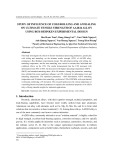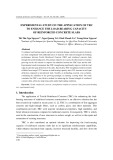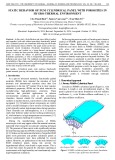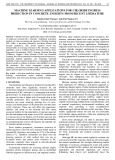
* Corresponding author.
E-mail addresses: aberto@gest.unipd.it (F. Berto )
© 2015 Growing Science Ltd. All rights reserved.
doi: 10.5267/j.esm.2014.12.001
Engineering Solid Mechanics 3 (2015) 35-42
Contents lists available at GrowingScience
Engineering Solid Mechanics
homepage: www.GrowingScience.com/esm
Tensile fracture analysis of blunt notched PMMA specimens by means of the
Strain Energy Density
A. Campagnolo and F. Berto*
University of Padova, Department of Management and Engineering, Stradella S. Nicola 3, 36100 Vicenza, Italy
A R T I C L E I N F O A B S T R A C T
Article history:
Received September 6, 2014
Accepted 12 November 2014
Available online
12 December 2014
In this paper
,
a volume criterion based on a simple scalar quantity, the mean value of the strain
energy (SED), has been used to assess the static strength of notched components made of
Polymethylmethacrylate (PMMA). The local-strain-energy based approach has been applied
to a well-documented set of experimental data recently reported in the literature. Data refer to
blunt U-notched cylindrical specimens of commercial PMMA subjected to static loads and
characterised by a large variability of notch tip radius (from 0.67 mm to 2.20 mm). Critical
loads obtained experimentally have been compared with the theoretical ones, estimated by
keeping constant the mean value of the strain energy in a well-defined small size volume. In
addition, some new tests dealing with V-notched specimens with end holes have been carried
out to investigate the effect of the notch opening angle.
© 2015 Growing Science Ltd. All rights reserved.
Keywords:
Polymethylmethacrylate
U-notch
V-notch
Static
Elasticity
Strain energy
1. Introduction
When we want to assess the strength of notched components, both under fatigue and static loads,
there is the necessity of introducing a material-dependent parameter, which typically has units of length.
In the literature there are different group of methodologies. The Cohesive Zone Model (CZM) is one
of the most important approaches. It was first proposed for concrete and later successfully extended to
brittle or quasi-brittle failure of a large bulk of materials and in particular PMMA specimens (Gomez
et al., 2000; Elices et al., 2002; Gomez et al., 2005). Another useful failure criteria, employed for
analysing theoretically the brittle fracture in cracked or notched members, is the maximum tangential
stress (MTS) approach (Ayatollahi et al., 2006, 2011; Ayatollahi and Aliha 2009; Torabi, 2013a, b,c;
Mirsayar and Samaei, 2014).
A coherent theory of fracture that can consistently account for the fracture behaviour of both sharp
cracks and blunt notches was proposed by Sih (1974) by applying the strain energy density (SED)
criterion to the bulk of the material near the notch surface. The parameter S is the product of the strain

36
energy density and a small distance from the point of singularity. Failure was thought of as controlled
by a critical value of S, whereas the direction of crack propagation is determined by imposing a
minimum condition on S. Different from Sih's criterion, which is a point-wise criterion, the averaged
strain energy density criterion (SED) states that brittle failure occurs when the mean value of the strain
energy density over a control volume is equal to a critical energy (Lazzarin & Zambardi, 2001; Lazzarin
& Berto, 2005; Berto & Barati, 2011; Lazzarin et al., 2014). For a review of the SED approach the
reader can refer to some recent papers (Berto & Lazzarin, 2009; Lazzarin & Berto, 2014). An important
advantage of the mean SED approach with respect to the stress based criteria is the mesh independency
(Lazzarin et al., 2010). The latest developments and applications have been presented in (Pook et al.,
2014; Campagnolo et al., 2015) by highlighting the capacity to automatically take into account also
three-dimensional effects.
The approach will be applied here to a number of experimental data taken from the literature (Zheng
et al., 2003) and obtained from static tests carried out on PMMA cylindrical specimens, weakened by
blunt U-notches. The experimental values of the critical load are compared with the theoretical
predictions based on SED showing a sound agreement. Finally to consider the effect of the notch
opening angle some tests have been carried out by the present authors (Berto et al., 2013) on symmetric
V-notches with end holes. The final assessment based on SED shows a good agreement between
experimental results and theoretical values.
2. Analytical Frame: strain energy density for blunt V-notches under mode I loading
The SED approach is based on the idea that under tensile stresses failure occurs when the averaged
value of the strain energy over a control volume (area in plane models) W reaches the critical value
Wc, which obviously varies from material to material. If the material behaviour is ideally brittle, then
Wc can be evaluated by using simply the conventional ultimate tensile strength
t, so that Wc=t2/2E,
where E is the modulus of elasticity. In the case of blunt notches, the area assumes a crescent shape,
with Rc being its maximum width as measured along the notch bisector line (Fig. 1c). By using the
elastic maximum notch stress
max, it is possible to determine the mean value of the SED (Lazzarin &
Berto, 2005). Under plane strain conditions, a useful expression for Rc has been provided considering
the crack case (Lazzarin & Zambardi, 2001; Lazzarin & Berto, 2005):
2
t
IC
cσ
K
4π
8ν5ν1
R
(1)
Rc
Rc
2
2
Rc
r0
Rc
+r
0
(a)
(b)
(c)
Fig. 1. Critical volume definition for sharp V-notch (a), crack (b) and blunt V-notch (c).
3. Experimental data
The SED-approach is applied here to a set of data that refers to circumferentially U-notched round-
rod specimens tested under tensile loading, made of a commercial un-oriented PMMA (Zheng et al.,
2003). The specimens were characterized by three values of the notch tip radius ρ = 0.67, 1.32 and 2.20
mm. The material was characterised by a Poisson’s ratio
= 0.4, a modulus of elasticity E = 3.20 GPa
and a fracture toughness KIC ≈ 1.00 MPa m0.5. The value of the linear elastic ‘critical tensile stress’ at

A. Campagnolo and F. Berto / Engineering Solid Mechanics 2 (2015)
37
the notch root was 76.00 MPa, while the critical strain energy Wc was 0.90 MJ/m3, respectively. The
stress-strain curve showed a linear elastic trend up to failure.
To consider also the effect of the notch opening angle some new tests have been carried out by the
present authors on double symmetric V-notched specimens with end holes characterized by a notch
opening angle equal to 30° and 120°. The geometry of the specimens is shown in Fig. 2. Three different
notch root radii were used in the experiments:
= 0.5, 1 and 2 mm.
2
0.5, 1, 2 mm
10 mm
50 mm
10
mm
200 mm
Fig. 2. Geometry of the PMMA specimens weakened by V-notches with end holes.
Being the PMMA the same used in (Gomez et al., 2007), the critical stress has been confirmed
equal to 130 MPa while the critical energy equal to Wc= 1.632 MJ/m3. All tests were performed at room
temperature under displacement control on a servocontrolled MTS bi-axial testing device (100 kN/
110 Nm, 75mm/ 55°). The load was measured by a MTS cell with ± 0.5 % error at full scale.
4. Application of the SED approach
Finite element (FE) modelling was performed using ANSYS 12.1 in order to determine the mean
value of the strain energy density (SED) at failure relating to the different specimens. The simulations
were conducted under purely linear-elastic conditions, in a state of plane strain for the plain specimens
while the axial-symmetry option was activated when considering the cylindrical specimens. The mesh
was performed by using the eight nodes element (PLANE 82). By using Eq. 1 and the above mentioned
properties for the material tested in (Zheng et al., 2003) and for the material tested by the present
authors, Rc results to be 0.035 mm in both cases. In order to evaluate the mean value of the strain energy
density at failure, the critical loads obtained experimentally on the tested specimens have been directly
applied to the FE-models.
5. Results and discussion
A synthesis in terms of the square root value of the local energy at failure, averaged over the control
volume (of radius Rc), obtained by FE-analysis and normalised with respect to the critical energy of the

38
material as a function of the notch tip radius
is shown in Fig. 3 and 4 for the new data. The plotted
parameter is proportional to the fracture load. All the values fall inside a scatter ranging from 0.8 to 1.2
and this states true for both the kind of PMMA considered in the present investigation. Then it is
possible to consider the averaged strain energy density (SED) at failure as constant and equal to the
critical value characteristic of the material.
Fig. 3. Scatter of the strain energy density values at failure for circumferentially U-notched round-rod
specimens made of PMMA (Zheng et al., 2003)
Fig. 4. Scatter of the strain energy density values at failure for specimens weakened by symmetric V-
notches with end holes and made of PMMA
In Fig. 5 the experimental values of the critical loads (open dots) have been compared with the
theoretical assessed values based on the constancy of the SED in the control volume (solid lines). As
shown in the figure it is evident that the trend of the predicted loads is in good agreement with the

A. Campagnolo and F. Berto / Engineering Solid Mechanics 2 (2015)
39
experimental one, being the maximum deviation less than 20% for the data taken from Zheng et al.
(2003). Table 1 reports the results of the FE-analysis, in terms of averaged SED at failure, and the direct
comparison between the mean experimental loads and the theoretical assessed values.
Fig. 5. Critical load Pcr versus notch radius
, comparison between theoretical predictions and
experimental data for specimens made of PMMA (Zheng et al., 2003); predictions based on
constant value 3
cm/MJ903.0W
Table 1. Strain energy as obtained from numerical analyses of circumferentially U-notched round-rod
specimens made of PMMA (Zheng et al., 2003). Wc=0.903 MJ/m3
D L a ρ P Pth 1
W
5.0
C1 W/W
mm mm mm mm N N MJ/m3
0.67
1641.33
2180.78
0.512
0.753
0.67 1698.58 0.548 0.779
11 110 1 0.67 1787.64 0.607 0.820
0.67 2150.26 0.878 0.986
0.67 2468.35 1.157 1.132
0.67 2512.88 1.199 1.152
1.32
2182.07
2689.63
0.594
0.811
1.32 2608.31 0.849 0.970
11 110 1 1.32 2869.14 1.028 1.067
1.32 2900.95 1.050 1.079
1.32 3199.95 1.278 1.190
1.32 3219.03 1.293 1.197
2.20
2951.84
3107.33
0.815
0.950
2.20 3002.73 0.843 0.966
2.20 3149.05 0.927 1.013
11 110 1 2.20 3702.52 1.282 1.192
2.20 3950.63 1.460 1.271
2.20 4001.53 1.497 1.288
Dealing with the new data, Fig. 6 shows the experimental values of the critical loads compared with
the theoretical one, in the case of a notch opening angle equal to 30°. The relative deviation between












![Bài tập tối ưu trong gia công cắt gọt [kèm lời giải chi tiết]](https://cdn.tailieu.vn/images/document/thumbnail/2025/20251129/dinhd8055/135x160/26351764558606.jpg)













